This blog is an extraction of the session “Service Bus: The on-ramp to Azure” presented by Ashish Chhabria, Product Manager in Azure, Service Bus at Integrate Remote 2020.
Introduction
Microsoft Azure Service Bus is a fully managed enterprise integration message broker. Service Bus can decouple applications and services. Service Bus offers a reliable and secure platform for asynchronous transfer of data and state.
In this blog, we’ll explore some of the exciting stuff of the Service Bus.
The Ideal Message Broker?
Whenever we try to build an application, we will think about functional and non-functional requirements. The Below image briefly explains it.
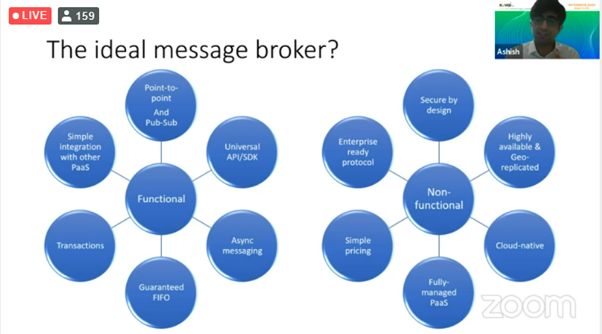
Now let us do some comparison between Service bus and other MQs in the market.
- Service Bus can be integrated with Azure Security with Private link and BYOK (Bring Your Own Key) encryption in which we cannot do it with other MQs.
- It can be integrated with other Azure Services such as Event Grid, Logic App, Functions, and Monitoring where you cannot do the same with other MQs.
- It is a fully managed PaaS and it’s very useful for business applications.
- It provides you High Availability and disaster recovery, but you cannot expect the same behavior with other MQs.
The only thing missing is the Stable SDKs, but it wouldn’t impact the usage of Service Bus Queues.
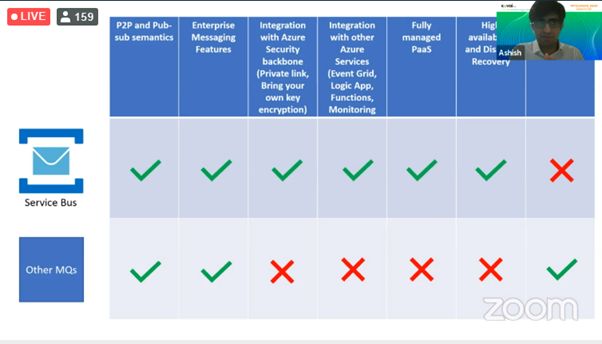
In the above comparison, we saw the possibilities of integrating Azure Service bus with other resources like Event Grid, Logic App, Functions, etc. In Azure, we can only link resources together, but we cannot see how they are connected to other resources or we cannot visualize how they are sharing the data. But with Service Map, a feature in turbo360 achieve total visibility of coupled resources.
Native Support for JMS 2.0
This is excellent news, native support for JMS 2.0 over AMQP and this can be utilized in Azure Service Bus Premium. It provides you with the following capabilities.
- Full Parity – Closing the gap on their JMS implementation
- Zero *code change – Bring your existing JMS and Spring applications
- Utilize existing EAI Connectors – popular integration connectors can connect seamlessly
- [Bonus] Large Messages – support for message payloads up to 100 MB (for both JMS and non-JMS clients)
How did they achieve it?
They observed the Qpid project and they were able to build some sample applications that connect with Service Bus. And then,
- They analyzed the AMQP Frames
- They made some changes to the Service side to Service Bus to respond to these AMQP frames.
- They also introduced the Service Bus specific JMS Connection factory.
Roadmap to full JSM Parity
The main aim of the Service Bus is to achieve full parity. They are trying it since the start of Service Bus Queue.
40% Parity – Before June 2020
- Connect to pre-created entities
- No support for Temporary entities
- No support for Subscribers
- No support for Queue/Topic Browsers
80% Parity – Public Preview June 2020
- Auto Create entities over AMQP.
- Queues/Topics
- Temporary Queues/Topics
- Client-Affine Subscriptions (scoped to a “client-id”)
- Shared/Unshared durable Subscriptions.
- Shared/Unshared non-durable Subscriptions
- Message Selectors
- Delivery Delay (scheduled messages)
- Queue and Topic Browsers (Peek)
Full Parity – GA and Beyond
- Durable terminus (link recovery)
- “NoLocal” features for subscribers
- RBAC support for JMS clients
How can you use it?
This is just going to be straight forward. Let’s say you have an existing java or spring application; you can just import azure-servicebus-jms and provide the respective Service Bus Configuration and that’s it the magic occurs.
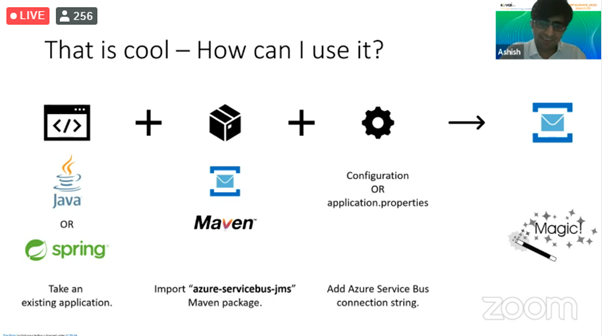
Here comes the demo with some Realtime example.
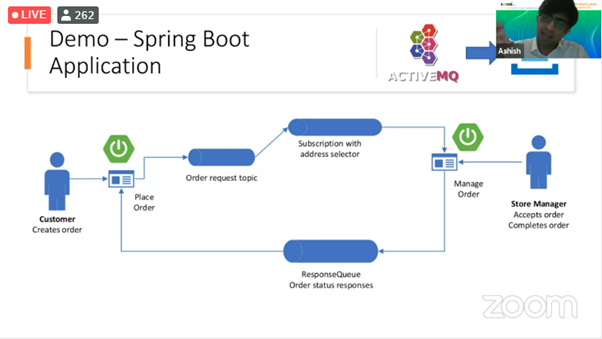
The scenario is very simple. Whenever the user places an order, the request goes to the respective ‘order request topic’ which then goes to the subscription with address selector, based upon the city the store manager accepts the order. Once it is accepted, the responses will be sent over to the response queue which will update the status of the order.
He ran this demo with Active MQs and later he replaced the same with Service Bus. The difference after replacing with Service Bus is that the entities will be created on the fly, so it is automatically created over AMQP. And this functionality is achieved with minimal code change.
Modernization begins with Azure Service Bus
Basically, Service Bus targets two scenarios, lift and shift or Modernize. But now they are thinking to make it as both modernize as well as lift and shift.
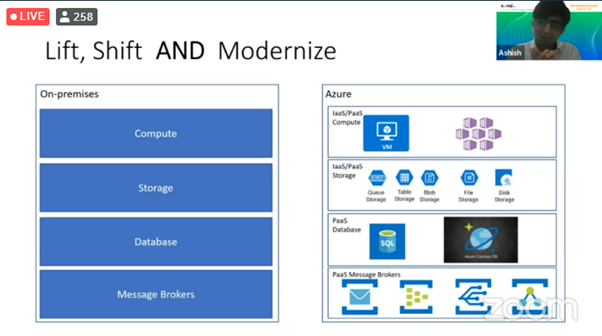
Let’s say we have on-premises stuff such as compute, storage, database, and message brokers. When we go onto the cloud it can be replaced with IaaS/PaaS Compute, IaaS/PaaS Storage, PaaS Database, and PaaS Message Brokers respectively. And they recommend Service bus as their top cloud message broker.
Below are some of the key differences between Service Bus and other MQ’s regarding the Deployments & Disaster recovery and Usage & Management.
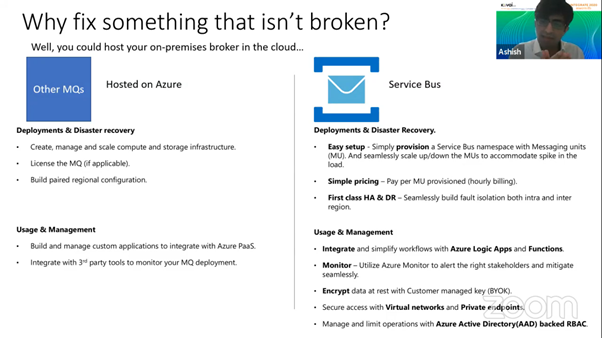
Spring Azure is getting bigger and better and below are some of the interesting stuff which you can take into notice.
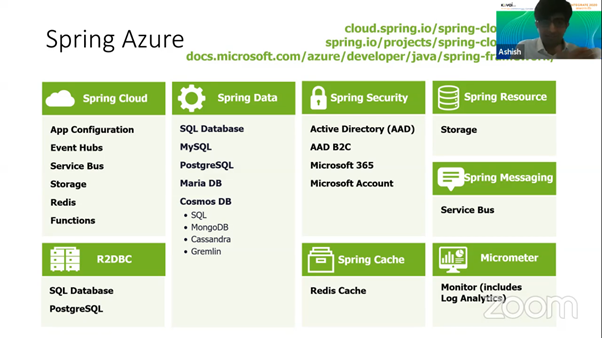
More Updates on Service Bus
The following are some more updates on Azure Service Bus.
- Service Bus Explorer on the Azure Portal – Preview now available for all namespaces
- Bring your own key (BYOK) encryption – Native integration with Azure Key Vault to encrypt your data with your key
- Private Endpoints – Service bus in the cloud, through a local endpoint
Now resubmit/send your message to an API endpoint with Turbo360 and achieve govern and audit by knowing who resubmitted the messages and when they did.
Question and Answers
- Are you supporting Distributed Transaction with JMS?
Answer: Actually, the Azure Service Bus team is evaluating the support in Long-term but in the short-term, it’s a no.
\2. Is there any correlation feature available in messages of Service Bus
Answer: As of now you can use the session ID for correlation, but if you want more definitely Azure Service Bus team will look to it.
Achieve correlation of messages with Turbo360’s BAM. Business Activity Monitoring\(BAM) is a feature in Turbo360, which helps users to have an \End to End tracking of messages\ flowing in your Business process.
Conclusion
In this blog, we explored some of the interesting updates on the Azure Service Bus. The main key takeaways are,
- Native Support for JMS 2.0
- Trying to achieve Full Parity
- Azure-servicebus-jms maven package which can be used in your respective spring or java application to do the magic.
Service Bus is becoming more powerful day by day and once it achieves its full parity, it is going to be one of the most performant message brokers.






